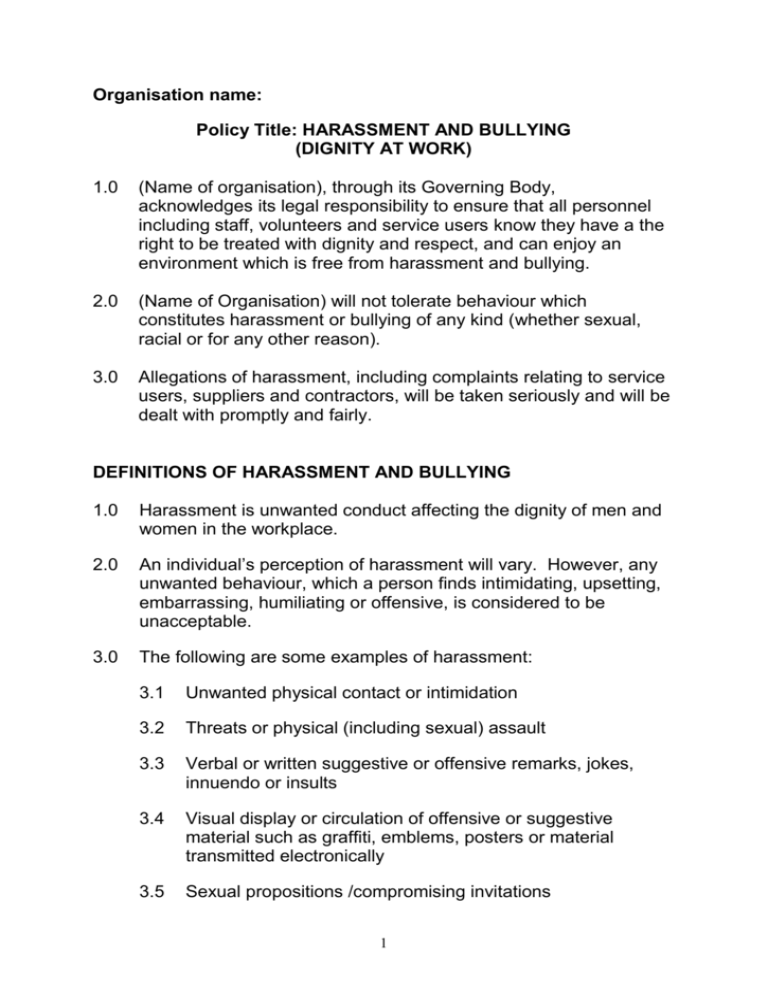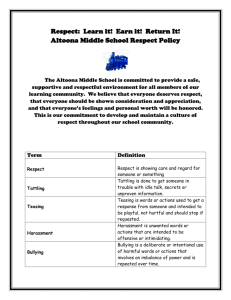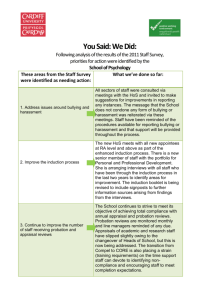
Organisation name:
Policy Title: HARASSMENT AND BULLYING
(DIGNITY AT WORK)
1.0
(Name of organisation), through its Governing Body,
acknowledges its legal responsibility to ensure that all personnel
including staff, volunteers and service users know they have a the
right to be treated with dignity and respect, and can enjoy an
environment which is free from harassment and bullying.
2.0
(Name of Organisation) will not tolerate behaviour which
constitutes harassment or bullying of any kind (whether sexual,
racial or for any other reason).
3.0
Allegations of harassment, including complaints relating to service
users, suppliers and contractors, will be taken seriously and will be
dealt with promptly and fairly.
DEFINITIONS OF HARASSMENT AND BULLYING
1.0
Harassment is unwanted conduct affecting the dignity of men and
women in the workplace.
2.0
An individual’s perception of harassment will vary. However, any
unwanted behaviour, which a person finds intimidating, upsetting,
embarrassing, humiliating or offensive, is considered to be
unacceptable.
3.0
The following are some examples of harassment:
3.1
Unwanted physical contact or intimidation
3.2
Threats or physical (including sexual) assault
3.3
Verbal or written suggestive or offensive remarks, jokes,
innuendo or insults
3.4
Visual display or circulation of offensive or suggestive
material such as graffiti, emblems, posters or material
transmitted electronically
3.5
Sexual propositions /compromising invitations
1
3.6
Derogatory name-calling or ridicule or using colloquialisms
3.7
Gossip or slander
3.8
Exclusion
This list of examples is not exhaustive
4.0
Harassment may be related to age, sex, race, disability, religion,
sexual orientation, nationality or any personal characteristic of the
individual, and may be persistent or an isolated incident.
4.1
The legal definition of harassment also requires the
behaviour to have ‘the purpose or effect of violating people's
dignity or creating an intimidating, hostile, degrading,
humiliating or offensive environment.'
4.2
The key is that the actions or comments are viewed as
demeaning and unacceptable to the recipient.
5.0
Harassment can involve a single serious incident or may be
continuous and spread over a period of time. It is the impact of the
behaviour on the individual that is relevant, not the motive or
intention that was behind the alleged harassment.
6.0
Bullying may be characterised as offensive, intimidating, malicious
or insulting behaviour, an abuse or misuse of power through
means intended to undermine, humiliate, denigrate or injure the
recipient.
7.0
The following list of examples is not exhaustive but bullying
behaviour can include:
8.0
7.1
Belittling someone in front of others
7.2
Setting unachievable deadlines or unequal workloads
7.3
Excessive supervision
7.4
Isolation or non-co-operation
Bullying is normally of a persistent nature, wearing down the
individual concerned and it may cause them to suffer stress. It
crosses all boundaries and contrary to common belief, whilst it is
2
sometimes an issue between a manager and team members, it
maybe the other way round. It can also arise between colleagues
where an individual in a group becomes the butt of practical jokes
and abuse etc.
9.0
Firm management is not necessarily bullying, and a manager’s
criticism of unsatisfactory work performance should not be
confused with bullying. Managers are entitled to set standards and
make clear any aspects of performance, which are unacceptable,
providing they are consistent throughout the team.
10.0 The key factor to all types of harassment and bullying is that it is
unwanted and unwelcome.
PROCEDURE
1.0
2.0
(Name of organisation) will address and endeavour to eliminate
harassment and bullying within the organisation by:
1.1
Promoting a positive working environment where
everyone is treated with respect
1.2
Ensuring that all allegations of harassment and bullying are
fully investigated
1.3
Providing support to those who feel that they have been the
target of, witnessed or been accused of, such abuse
1.4
When appropriate, using every effort to initially resolve the
situation informally. Some incidents, however, by virtue of
their serious nature will need to be dealt with immediately
under the formal procedure
1.5
Using the Disciplinary and Complaints procedures where
necessary
1.6
Providing high quality training and ongoing guidance for all
personnel which will help to prevent the occurrence of
harassment.
It is the impact of the behaviour on the victim which is the key to
deciding whether or not a complaint of harassment or bullying
should be investigated and not the intention of the perpetrator.
3
3.0
(Name of organisation’s) aim is to develop a culture in which
harassment and bullying are known to be unacceptable and where
individuals are confident enough to bring complaints without fear of
ridicule or reprisal.
4.0
All personnel have a responsibility for challenging all forms of
harassment and bullying, and for upholding personal dignity.
5.0
All related correspondence and written records of investigations
will be retained in accordance with the Data Protection Act.
6.0
Vexatious claims:
6.1
Any employee who makes a deliberately mischievous,
malicious or vindictive complaint of harassment will be dealt
with through the disciplinary procedure.
4
Date this policy came into effect
Next Review Date
Name or position of person
responsible for this policy
Other related policies
Relevant legislation
Useful information
Date approved by Governing
Body
As agreed by Governing Body
Allegations of Abuse
Capability
Complaints
Employment
Equality
Human Rights
Supervision and Support
Whistleblowing
Data Protection Act 1998
5
PRACTICE NOTE
Issued to:
All personnel
Issued by:
SUBJECT:
No:
HARASSMENT &
BULLYING (DIGNITY AT
WORK)
Date issued:
Date amended:
For Information
to:
Some organisations now choose to call this policy Dignity at Work rather
than Harassment & Bullying.
See appendix 1 for a manager’s guide.
6
Appendix 1
MANAGERS GUIDANCE NOTES
1. INTRODUCTION .................................................................... 7
2. PREVENTION ........................................................................ 7
3. INFORMAL ACTION ............................................................... 8
4. FORMAL PROCEDURE ......................................................... 8
1. INTRODUCTION
As a manager you have a moral and legal duty to ensure that the Dignity
at Work policy is observed. The Company expects you to lead by
example and never to indulge in harassment or bullying yourself. You
also have a particular role in ensuring that instances do not occur.
In addition you have a responsibility to take action if you witness
occurrences of harassment or receive a related complaint.
2. PREVENTION
To help prevent bullying and harassment you must make all of your staff
and volunteers aware of the Dignity at Work policy and procedure and
maintain an environment that is free of potentially offensive material,
such as posters.
Encourage an environment where personnel feel able to report incidents
of harassment and you should treat any allegations of harassment
seriously and in confidence. Do not dismiss complaints or instances of
unacceptable behaviour without proper consideration.
You should be aware of the effect that harassment can have on a
person which can include loss of confidence and self esteem which in
turn leads to a drop in performance. Individuals subjected to
harassment may exhibit some or all of the following:
Repeated short term absences or poor timekeeping
7
A marked deterioration in performance standards
Change behaviour, possibly becoming withdrawn or anxious
Loss of concentration and / or self-esteem.
If you have concerns about any of your personnel in relation to the
above you should contact the Human Resources Manager, where
available.
Harassment and victimisation are discrimination and as a manager you
may be held liable at an employment tribunal for the behaviour of your
staff. In addition there is a legal responsibility to protect staff from
harassment by service users.
3. INFORMAL ACTION
You must take prompt action to stop harassment as soon as it is
identified, making it clear to personnel that this kind of behaviour is
unacceptable and may be treated as a disciplinary matter. In many
cases this will resolve the problem without the need for further action.
Some individuals, who have been harassed, do not find it easy to seek
help, they may feel reluctant to take the matter up with the alleged
harasser or even turn to their colleagues for support. The individual may
also decide not to take action and normally in these cases their decision
should be respected.
However you should be prepared to act on behalf of any member of
personnel who brings an informal complaint under the Dignity at Work
policy. This will involve speaking to the alleged harasser on the
individual’s behalf, gaining agreement that the behaviour will stop and
monitoring to ensure that it has.
Seek advice from the Human Resources Manager (if available) in
circumstances where you decide that further action is appropriate,
despite the member of personnel not wishing to use the formal
procedure.
4. FORMAL PROCEDURE
A formal complaint must be made in writing to either you, a Senior
Manager or the Human Resources Manager (where appropriate), it
should include;
8
the name of the person who is allegedly harassing/bullying the
member of personnel
the nature of the alleged harassment/bullying
dates and times when the incidents occurred
names of any witness
any action, if any, they have already taken to stop the alleged
harassment/ bullying
If you receive a formal complaint you must contact the Human
Resources Manager (where appropriate) or the most senior manager.
You must send a written acknowledgement within 3 working days of
receiving the formal complaint. Also arrange a meeting at a mutually
agreeable time and place to conduct a preliminary interview with the
member of personnel to clarify the nature of their complaint and to verify
that the complaint is appropriate to the Dignity at Work procedures.
Another manager will be appointed by the Human Resources
department (where appropriate) or Senior Manager to carry out a
thorough, confidential, investigation. The investigator will be someone
who has no involvement in the complaint.
9





![Bullying and Harassment Advisor role des[...]](http://s3.studylib.net/store/data/006976953_1-320eb77689e1209d082c9ec2464350ee-300x300.png)




